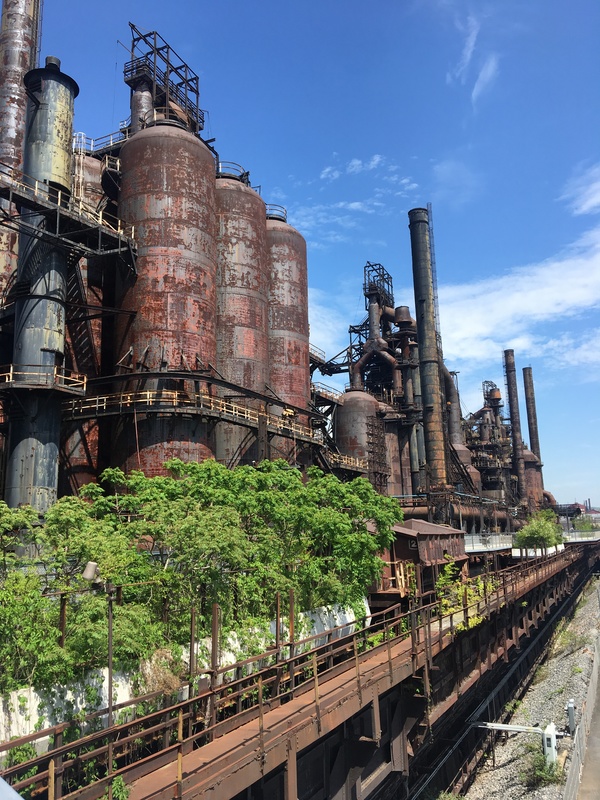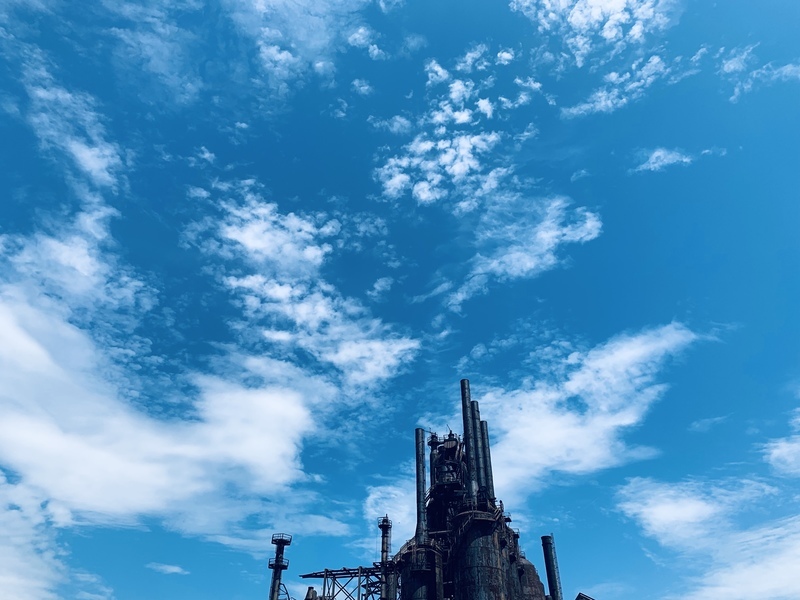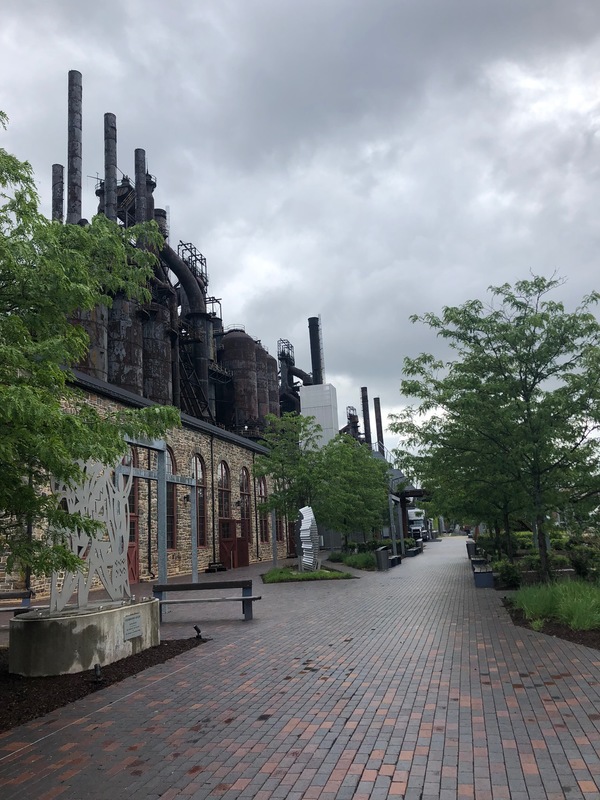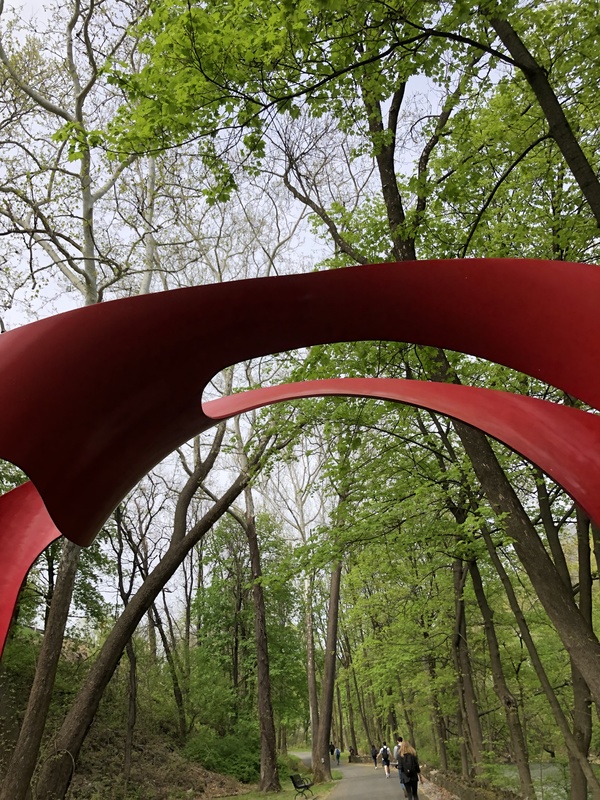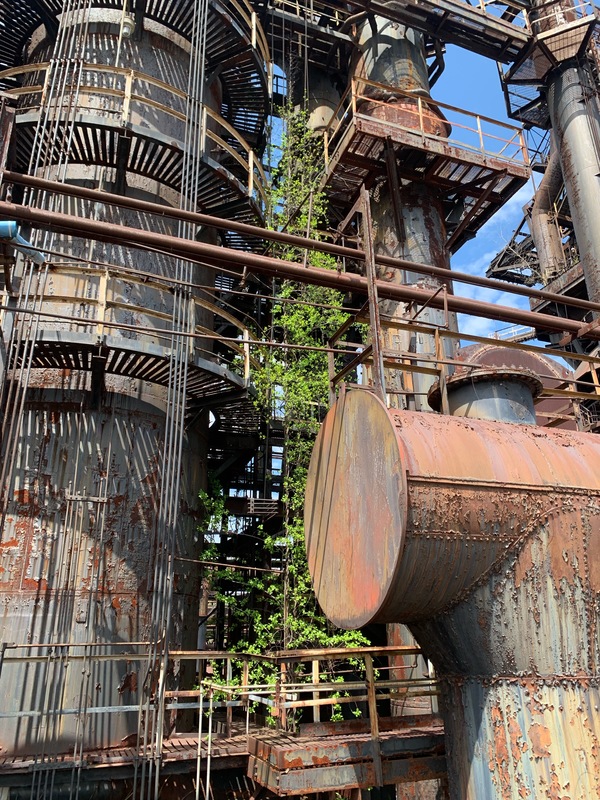Environmental Studies Class Exhibit: Rust to Green
This exhibit was created by students in Dr. Andrea Armstrong's Spring 2019 Environmental Studies course at Lafayette College. The creative nonfiction essays and accompanying photographs reflect on change over time in the landscape of the Lehigh Valley, and explore the dynamics between the people and the environment in the region today.
The SteelStacks and Me
By Maura DiGuglielmo
A common interest or drive to complete a mission often fosters teamwork and a sense of belonging and purpose. However, the loss of the project itself can also threaten to destroy the relationships made while working on it. One of the places this is the most prominent in the Lehigh Valley is the Bethlehem SteelStacks. The SteelStacks first produced iron for local railroads, and moved on to steel which helped build iconic structures Chrysler Building and the Golden Gate Bridge.
Blue-collar workers performed hands-on labor tending to the 24/7 operating SteelStacks, and are the ones who really got to know the place. This was their job, their source of income, and their sense of pride. The Stacks meant everything. These workers and their families loved the SteelStacks and the financial opportunity it gave them when college was not a viable option, that they would even engrave their initials into the tracks and stood with their families as the last furnace burned in 1995.
My grandfather was born the same year the SteelStacks hit 13,000 workers in another small and developing town in Pennsylvania. The town itself was named after the glass factory owner’s wife, Jeannette. This factory required a huge workforce, my great-grandfather included. Afterall, the Chrysler Building also needed windows. My grandfather always talks of how everyone knew everyone in the town and they coined themselves “the city of champions” because of their production ability and esteemed high school football reputation.
The loss of the Stacks meant the loss of what initiated the growth of Bethlehem, and all the hardworking people that had dedicated their lives to the success of them. However, it would also be impossible for these workers to not see the exponentially growing Lehigh University and Lafayette College, drawing in funding for new buildings, new ideas and majors, and new professors and students from across the country like a magnet. Times were changing, not only because of the countries decrease in demand for steel from advancements in technology and efficiency, but in the types of people in their towns. They now had white collars.
Some saw football as a way out, but my great-grandfather and great-grandmother placed an emphasis on education and this allowed my grandfather to later serve in World War II, study to be a civil engineer, and buy a heating and contracting company that he still works at everyday, despite being technically retired. This company gave way to two generations of well-educated students and workers, going off to work in fields that were so much more than pure production, but in education, sustainability, engineering and the arts. My grandfather often gets overwhelmed with emotion when expressing proud he is for how far we have come, pursuing our true passions and interests, in a higher education setting. I came to the Lehigh Valley, not to work at the SteelStacks, but to pursue education. When outside Lafayette’s campus and in the broader Lehigh Valley community, I am often looking at the rock outcrops surrounding my college and the Stacks. Limestone used to be seen as a resource, mined and used for steel production, but for me is key to the deep geologic past. One of warm water reefs, sandy shores and prehistoric plants and animals.
Despite his praise for our success in the modern day, stories of the past continue to be uttered from my grandfather’s mouth, to the point where I knew them as well as I did to easily relay them to you. They are lain with regret that he no longer lives in a town with six aunts and uncles within a one mile radius from him, and is now not able to know every single person he passed. The small town feel pride and the sense of purpose associated with the production of useful goods is what brought the town together. Most of that side of my family lives in Westchester New York, but we are miles away, not feet. All of my aunt and uncles, and the oldest of my cousins, left home to attend college, and found seperate jobs. Lives got busier. Busyness turned into a disconnection.
“Steel company is gone, but the structures are still there to be enjoyed by millions and millions of people everyday” -Lynn Beedle, professor of engineering at Lehigh University, as posted on signage along the Bethlehem SteelStacks. My grandfather does not miss hearing horror stories of glass factory mishaps from his father, or breathing in polluted air on his way to school. He misses what Bethlehem and the SteelStacks never let go of. Bethlehem, and the surrounding community, didn’t tear down the Stacks, but rather allowed them to cool off, and gave them a new purpose. The new citizens of the Lehigh Valley can now ice skate, gamble, listen to music, create art and enjoy fine dining right on its campus. Forever promoting a celebration of what it truly means to be apart of Bethlehem. This is a place where a professor, a New York City commuter, a division one athlete and history buff can leave their labels at the door or enjoy the place they physically live and take pride in all that Bethlehem has created, how that creation has changed forms, and how the community has grown, but at the same time stayed exactly the same.
The Mantra of the Industrial Revolution
By Amanda Willett
I don’t know what happens after industrialization, but I hope that we can use the mistakes of our past as a lesson for the future. The air smells like a mix of fish, chemicals, river water, and goose poop.
The temperature is comfortable, and it feels good to be outside. The river is gently (or at least that is what it wants you to think) flowing past me, which I can see through a thin line of trees. This is the river that I know, the river that I know better than I know any of my friends on campus, and the river that knows me. I have run over 300 miles on the D&L Trail this past year, which I am now standing on. It sits caught in the middle of the canal and the river, which is highly significant. When you are running along the trail, you can smell what you are not able to see. The Delaware and Lehigh National Heritage Corridor has worked diligently to preserve and revitalize this historic place. Their objective has been to conserve green space for public use, document and interpret our heritage, celebrate our community and region, and create partnerships and programs for long-term sustainability. This trail and the canal are an example of their efforts, an example of what happens after industrialization, and how we go from rust to green. However, sitting right next to this man-made feat of engineering, an example of man-made solutions, flows a naturally formed river that is riddled with man-made problems. These problems come in the form of dams and pollution, both of which have significantly affected the environment of the river and the surrounding land.
Easton sits at the convergence of the Morris, Delaware, and Lehigh canal systems. A once thriving industry has left behind a skeleton, and while the canal system has been turned into a green space, the city of Easton still struggles around it. The canals were originally constructed in the early 1800’s to carry anthracite coal from carbon county, where it was very easy to mine, to the market in Philly. At the time, this anthracite coal seemed like the solution to the energy crisis because coal contains 98% carbon, gets very hot, and is smokeless. However, we are now learning that what we once thought was a saving grace is actually Satan in disguise taking his grip on society and slowly decimating the planet. Satan had decided to play the long game, and he had even bigger plans than we could have ever imagined.
If you follow the Lehigh River upstream from Easton, you will eventually find yourself in the city of Bethlehem, which in 1857 became the belly of the industrial revolution. Running 24 hours a day 365 days a year, this place was the second largest steel manufacturer in the nation. It is no coincidence that this industry came into existence around the same time the Lehigh canal coal was triggering the American industrial revolution. This led to 130 years of iron and steel manufacturing which made a century of American progress and innovation possible. However, this same progress and symbol of pride has come at a price that we are currently paying. The Bethlehem SteelStacks have been a large contributor to environmental and social changes, but in the worst kinds of ways. Nobody is talking about this. Rather than demolish the historic mill or walk away from it and let it fall apart, the Lehigh Valley rallied to bring a new life to the former steel campus. Now, the SteelStacks is a place that caters to service activities and white collar play. This includes the casino, ice skating rink, concert venue, and other places for music, art and entertainment. However, while so many beautiful things were created at this plant, so too was a type of potentially catastrophic destruction that will not be fully felt until my generation grows old. Nobody is talking about this. This form of destruction, unsurprisingly, is not mentioned in any of the educational boards that you will see if you go to visit. Nobody is talking about this. The Bethlehem SteelStacks are representative of a place that should not only be preserved and protected, but a place that should be used as an environmental lesson for our future. Sitting in the heart of Bethlehem is an example of how industry failed us. Despite the shiny new buildings and green spaces, there are still many places on the campus where there is evidence of nature’s inability to reclaim what was lost in this now deceased industrialized belly. You can see evidence of this in the yellow and dying trees that are trying to press up through the steel stacks. Some of them are making it, but the majority are not. In this way the people of the Lehigh Valley and mother nature are united, because while the City of Bethlehem is fighting for revitalization, so too is nature. While this silent fight is only visible if you chose to take notice, the air still smells like industry when the wind blows, and this cannot be hidden. The rock record will show a history of unparalleled CO2 emissions, and this cannot be hidden.
There was a time when industrialization was sold as the future of progress, and we have stepped into an era where it is time for a new form of progress to be defined. The Bethlehem SteelStacks went out of business because management put short term profits ahead of long term goals. Is this not the mantra of the industrial revolution? I do not know what happens after industrialization, but I do know that it must include an education that embraces the environmental mistakes of our past so that we can seek to learn from them in our future.
From Rust to Green: Bethlehem SteelStacks
By Ashley Ender
It was the hottest day of the spring, reaching 80 degrees Fahrenheit. Was it always this hot during early May? I remembered that the weather has been weird the past couple of years. As I walked along the Hoover- Mason Trestle of the Bethlehem SteelStacks, all I could think about was jumping into the Lehigh River to cool off. The only barrier between the river and me was the gigantic signature factory building of Bethlehem Steel. Sadly, there would be no swimming today.
This large structure is one that I have seen an infinite number of times while driving to and from school when I was younger, but I never realized how huge it really is. The entire area of the building that looks like a bunch of large pipes, beams, and ladders brought together, is covered in rust, making it give off a reddish-brown color. This rust has come with the time this structure, and the whole of Bethlehem Steel, has been left to sit. I looked up at how tall this building was, and tried to imagine what it would have been like to work here and have to climb ladders that went way above my head. I couldn’t.
As I kept walking, I read a sign about the dangers that the workers faced each day when they arrived at their jobs. When the majority of the employees went to work at Bethlehem Steel, they risked their lives for lower pay than what they deserved. Many workers died in the grueling process of making steel. I thought that I was overheated then, but could you imagine the heat during the workday at this place during the summer? These people had to work in conditions of melting metals and creating steel from pig iron by using blast furnaces. They had to deal with fire and heat every day. On top of these tough working conditions, the steel making process was not exactly compatible with a healthy environment in the Lehigh Valley. In fact, making steel releases tons of carbon dioxide into the air on top of other lesser known emissions of minerals, metals, and other pollutants. Yes, this work was important to make steel for weapons and other structures during World War II, but was it really worth the danger during the process and the unforeseen consequences on the environment?
Looking around I notice how much this place of industry has changed. The Bethlehem Steel as a whole has been transformed into the Bethlehem SteelStacks, a place of entertainment and fun. One of my first experiences here was my first grade birthday party at the Steel Ice Center. I had a great time ice skating with my friends without a care in the world about what this place was before it was the ice rink. Since then, a movie theatre, event center, concert area, casino, and shopping center have all been added to create what everyone now knows as the SteelStacks. Bethlehem Steel, a place of industry and pollution, has become the SteelStacks, a small town full of entertainment and modernity. My grandfather used to come here to take inventory and order what the workers needed to make steel. Now, I, and thousands of other people, come here for Musikfest every year to watch up-and-coming and popular artists in concert. Instead of the occupational risk that used to exist here, the biggest danger at the SteelStacks nowadays is the multitude of drunk people who flock here during August for the music festival.
Finally, after finding some shade, I took a seat on one of the benches placed on the trestle. I was surrounded by a garden full of green plants and native flowers. I had just noticed that these were all along the trail with signs reading “native plants.” It was almost like they had something to prove with the fact that these were native to the area. To me, these gardens helped to hide the past pollution that used to come from this place. Maybe they serve as an attempt to reverse the toxicity produced here in the 1900s. I also noticed how right in front of me, where there was once a railway, there is now greenery growing on the ruined tracks. This greenness was not a part of the gardens, but somehow managed to grow on its own. Nature found its way, even in a place probably still covered with chemicals from the past. However, seeing this greenness grow over the rusty beams of Bethlehem Steel gave me a little hope that maybe one day the pollution leftover can be somewhat reversed to make a better environment.
While on the Arts Trail
By Anonymous
Junior year has probably been the worst year of my life so far, and definitely the worst year at Lafayette. As it is coming to a close, I can’t help but feel a little bit of relief in knowing that senior year cannot get any worse than this past year was. We have a week or so before finals, and I know I should be getting work done, but I need to clear my head for a little bit. I lace up my dirty, paint covered Nike sneakers and tie my checkpoint around my wrist. I leave the house without saying bye to anyone and start to let my legs carry me down the hill.
I enter the Arts Trail, an area that was once just a small towpath, along the Bushkill Creek, for coal transportation during the industrial revolution. Now the gravel path is gone, replaced by concrete. The old infrastructure that once aided the traveling along the way has been torn down and replaced by pieces of artwork from all over the country. Each piece is different and brings something new to the trail. For example, there is a new musical exhibit that mimics kids running along a fence with sticks. The metal rods that are set up mimic the fence, and when they are hit in order with a stick, they play a song.
I stretch my legs down the path. In and out, I try and focus on myself breathing. I feel tears starting to well up in my eyes. I have to stop and collect myself. I think about my friend Carter who won’t be coming back to Lafayette next year. He was one of the most well-liked kids on Lafayette's campus. He was involved in every student organization there was, and everyone seemed to know him. We had been friends since freshman year. He was one of the first friends I met and was the start of the group of people I would soon call all my best friends. We had a freshman wedding with all these friends and Carter and I got fake married. Carter and his roommate Seth always had their door open freshman year. It didn’t matter what time of the day or night it was, everyone was always welcomed there. People would constantly be in there hanging out, watching TV or even doing homework. Carter was the match that started the fire behind all of the good that was happening for my friends and I, freshman year.
I sit down on the ground in an area of the arts trail that is closer to the Bushkill. I watch leaves as they float down the creek and get tossed around in the ripples. I hear people passing along the trail behind me. I figured they probably think I am out of shape and needed to take a break, which isn’t false. I change my focus from the water to a structure that sits across the creek on the other side. The silk mill is a new up-and-coming hub for Easton. It had once been an industrial factory, but rather than tear it down like many other buildings like it, it is being remodeled. Different restaurants and stores are being put in. For example, there is a cafe, an ice cream shop, a winery, and several new apartments. I am amazed by the transformation one place could make, especially in such a short period. I envy the area’s ability to move on and change with the times. The metamorphosis that is happening to this place was something that I wish I could do to myself.
The verdict on Carter’s trial came out yesterday, and he had been found guilty. I didn’t know who to talk to, most of my friends who were close to him are abroad. I am feeling such a mix of emotions that I don’t even know how to comprehend what is actually happening. I feel relief about the fact that Carter would be leaving, but also sad about the fact that I am losing a friend. Guilt also overwhelms me because I feel like I shouldn’t feel bad for him, but I do. We get all sorts of training about how to prevent or help a friend who is sexually assaulted, but no one ever talks about what you are supposed to do if you are friends with the assailant. I go over to Seth’s room, and we both cried for a while, Seth and Carter don’t speak anymore. We don’t need to talk to know how each other is feeling. Just knowing someone is just as confused and as hurt as I am was enough.
I sit on the Arts trail for a few more minutes before I get up and finish my run. There is a sign at the end of the path that explains some of the history of the area, I had never read it before but for some reason, I decide that now is the perfect time to do so. There is some information on the renovations that have been done to the Arts Trail and Silk Mill and then at the end is a quote by a man I had never heard of. It stated, “Sometimes things begin in just the way they need to, but without evolution, they will soon fall and become irrelevant. Change and the ability to overcome is the only way society will be able to move forward.” I take in these words and do my best to recite them, then turn around and finish my run back to campus.
Sight of the SteelStacks
By Adriana Ventura
The tall-standing, eye-catching SteelStacks loom over the city with their rusted paint and steel scent as a constant reminder of the time when the river was running black and the air was heavy to breathe in. Or at least that is all I thought and imagined. The Lehigh Valley area is notorious for its industrialization period, and the rich history about the times of war and steel lives on with the sight of the SteelStacks glaring over the city. That thought meant nothing to me, at first, because, as an outsider, this place had no great significance to me. I questioned why the SteelStacks had not been taken down years ago since the city could build so many other new and modern things to lighten the mood. Personally, I would not want to see a broken down factory on my walk in the city, but now, those SteelStacks have shown me their importance and are here to stay. They no longer signify this idea of industrialization: they signify more. They go to show that the idea of “Rust to Green” as well as the idea of “Rust and Green” are both possible.
I see the tour buses parked diagonally next to each other along the parking lot, and I think about the way these people come in, take their pictures and move on with their lives. I did that myself. But, I saw some houses in the area, and I realized that there are families living there who cannot or simply do not want to get rid of and forget this place or era because it is integral to who they are. The Steelstacks symbolize a way of living for most of the residents and their families because it is deeply integrated into their culture and history. For those who lived here through this period, this factory running as well as when it stopped running had a direct or indirect impact on them. It was that realization that led me to finally understand the cultural significance of the SteelStacks, and that taking them down would never be an option. But, there was still the importance of making this space more attractive and safer for the environment. If the factory was removed then there could be shops, restaurants and even a park built to improve the community.
There has always been this binary mindset about most environmental issues: you either want all of the dams removed or none of the dams removed. In this case, we either want the SteelStacks to be maintained in good condition or bulldozed down. The discussions I have had in classes and outside of classes have led me to believe that we must sacrifice either our development and technology for the greater good of the natural environment, or vice versa. These extreme opinions, however, have thus limited my thinking, and, though I cannot speak for everyone, I think most people can at least partly admit to this truth. Although difficult to implement due to how idealistic it may seem, the movement towards creating a more balanced environment will prove to be the best way to allow human and nature survival.
The Bethlehem Steelstacks prominently demonstrate this balance, and it is breathtaking to see. As I walked on the trestle, I was captivated by a sight that has thus stuck with me. There was a beautiful, healthy, green vine growing, wrapping around a rusted, old metal chain. The contrast was incredible, and I stood at this spot for a few minutes trying to understand how it was possible. This was not the only place where I saw greenery intertwining with the steel of the SteelStacks, and the sight was unbelievable. There were trees, grass and plants growing and thriving in the deepest and darkest places of the factory, and I couldn't help but think about the hope I felt in every ounce of my body. The addition of both intended and unintended greenery throughout the trestle and parts of the factory gave a majestic balance between the world of industrialization and nature. I was left in awe and no words.
Throughout my walk across the trestle, I passed certain areas where my nose was struck by the strong smell of what I had immediately described as a roller coaster. After writing this down, I slowly shook my head as I quickly realized that both of the structures are built of steel. As I took a few steps, taking note of my newfound realization, I was distracted by a new sweet smell that could only be coming from the flowers and trees, until a busy buzzing bee passed by my ear and scared me to death. The smells contrasting with each other demonstrated the idea of development and nature harmoniously coexisting in this place. There is no need to pick just one.
The environment I see now does not seem as polluting and dirty as I imagined it was looking at the pictures of oil, sweat and dirt covered factory workers. There has been great change in this environment; however, the bit of industrial residue in certain places does not allow flora to grow, but the other spaces are enough to provide and encourage hope for a greener future. The SteelStacks were once a symbol of industrialization, development, capitalism, but those ideas have negatively impacted our environment and health. The SteelStacks now are a symbol of the best of both worlds: industrialization and nature. We do not have to sacrifice one for the other because there is always a middle ground that can be created.


